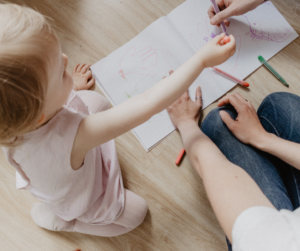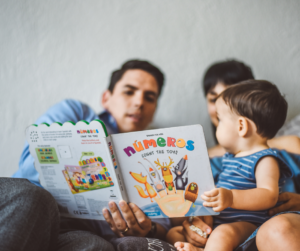Family life would be infinitely less exasperating for parents, and more enjoyable for children as well, if parents would accept these simple principles about children:
PRINCIPLE I:
LIKE EVERYONE ELSE CHILDREN HAVE NEEDS, AND TO GET THEIR NEEDS MET THEY ACT OR BEHAVE
PRINCIPLE II:
CHILDREN DON’T MISBEHAVE; THEY SIMPLY BEHAVE TO GET THEIR NEEDS MET
This does not mean, however, that parents will like all of the behaviors that their children engage in. Nor should parents be expected to, for children are bound to do things that produce unacceptable consequences for their parents. Kids can be loud and destructive, delay you when you’re in a hurry, pester you when you need quiet, cause you extra work, clutter up the house, interrupt your conversation, and break your valuables.
Think about such behaviors this way: they are behaviors children are engaging into meet their needs. If at the same time they happen to interfere with your pursuit of pleasure, that doesn’t mean that the child is misbehaving. Rather, her particular way of behaving is unacceptable to you. Don’t interpret that the child is trying to do something to you–she is only trying to do something for herself. And this does not make her a bad child or a misbehaving child.
If parents would strike the word misbehaving from their vocabulary, they would rarely feel judgmental and angry. Consequently, they would not feel like retaliating with punishment, as in the situation with little David and his mother. All parents, however, do need to learn some effective methods for modifying behavior that interferes with their needs, but labeling the child as misbehaving is not one of them. Nor is punishment, of any kind.
PRINCIPLE III:
PARENTS CAN’T BE ACCEPTING OF ALL BEHAVIOR OF THEIR CHILDREN
You’re feeling rested and energetic and happy with the world. Jack, your 12-year-old, is playing his guitar with considerable gusto. It doesn’t bother you at all; in fact, you’re delighted to see him getting such a kick out of practicing. Jack’s behavior is seen through the top part of your window–it’s quite acceptable to you.
It is two days later, and you’re exhausted and trying to catch a half-hour nap. Jack again starts to play his guitar loudly. You know that you can’t drop off to sleep with that darned guitar blasting in your ears. It is very unacceptable to you-you see Jack’s guitar playing today in the bottom part of your window.
Are you being inconsistent? Of course. But for a very good reason. You are a different person today from the person you were two days ago. Being human, you change. But you were real then, and you are real today. If you had reacted consistently both days, you would have been unreal one of those days–phony, if you will.
Being inconsistent in your reaction to a child’s behavior is being a real person; it is also inevitable. Despite the advice of countless child-rearing experts, parents can and will be inconsistent. And I would say that they should be inconsistent.
PRINCIPLE IV:
PARENTS DON’T HAVE TO BE CONSISTENT WITH CHILDREN
But what about the effect on the child? In the first place, children understand that their parents have good days and bad, that one situation can be different from another. It happens to them! Second, kids grow to respect parents who are honest about their feelings and grow to distrust those who are not.
The traditional belief in being consistent also influences mothers and fathers to think that they must always be consistent or united with each other’s reactions to their child’s behavior. This, too, is nonsense. Parents are told to back each other up so that the child believes that both parents feel the same way about a particular unacceptable behavior.
What is wrong with this entrenched idea is that it requires one parent to be untrue to his or her real feelings. It asks one parent to play a role, be phony. Again, children are able to perceive such phoniness, and they dislike it. An adolescent girl confirmed this for me when she said, “I don’t respect my father–in fact I hate his weakness. Whatever my mother feels about things I do, he takes her side even though I know he doesn’t agree.”
Parents cannot hide their true feelings, and they should not try. Rather, parents should accept the fact that one parent may feel accepting of a behavior and the other feel unaccepting. The effective parent realizes that he or she will inevitably feel different on different days about the same behavior. Parents are people, not gods. They do not have to act unconditionally accepting toward all behaviors, or even consistently accepting toward one behavior. Neither should they pretend to be accepting in order to present a united front.
PRINCIPLE V:
PARENTS DON’T HAVE TO PUT UP A “UNITED FRONT”
While all children would undoubtedly prefer to be accepted all the time, they can constructively handle their parents’ unaccepting feelings when the parents send honest messages that match their true feelings. Not only does this make it easier for children to learn to judge the appropriateness of various behaviors, but it also helps them grow to see their parents as real persons–transparent, human, and people with whom they would like a relationship.
PRINCIPLE VI:
WHEN INFANTS BEHAVE UNACCEPTABLY, THERE IS A GOOD REASON, BUT YOU HAVE TO TRY TO GUESS WHAT IT IS
Sometimes parents find the guessing game easy; other times more difficult. The cliched “if at first you don’t succeed, try, try again” is the soundest advice I know for parents. Actually, parents can get quite good at the game because they get to know their offspring better and better. Parents have told me that they eventually learned to tell the difference between a wet-cry, a hungry-cry and a gas-cry.
“Let’s make a trade.” Another approach for changing unacceptable behaviors of infants and toddlers involves trading: substituting the unacceptable behavior for another behavior that would be acceptable to the parent.
Laura, your curious one-year-old, has found a pair of your new stockings, which she finds enjoyable to touch and tug on. You find this unacceptable because you’re afraid she’ll snag or destroy them. You go to your drawer and pull out an old pair that is already snagged and beyond being wearable. You place this pair in her hands and gently take away the new pair. Laura, not knowing the difference, finds the damaged pair equally as enjoyable to touch and tug. Her needs are met and so are yours.
Emilio is jumping up and down on the couch, and his mother fears that he will knock the lamp off the end table. She gently but firmly removes Emilio from the couch and proceeds to jump up and down with him on the pillows, which she removed from the couch and put on the floor.
Shelly, age 18 months, starts to get up on her dad’s lap on the very night he is dressed in his freshly cleaned light-colored suit. Dad notices that Shelly’s hands are covered with jam mixed with equal parts of peanut butter. Dad gently restrains Shelly, but then immediately goes to the bathroom, gets a wet washcloth, and wipes her hands clean. Then he picks Shelly up and puts her on his lap.
Again, when parents start thinking in terms of trading, they stop using punishment.
PRINCIPLE VII:
WHEN YOU CAN’T ACCEPT ONE BEHAVIOR, SUBSTITUTE ANOTHER YOU CAN
The nonverbal I-Message. Older children often modify their behavior after a parent sends them an honest message that conveys how the parent is affected by the child’s behavior, as in:
- “I can’t hear on the phone when there’s so much yelling.”
- “I’m afraid I’ll be late if you take so long to dress. “
- “l Iove that little dish, and I would be sad if it got broken.’”
But children too young to understand words won’t be influenced by such messages (called “I-Messages” because they convey to the child “Let me tell you how I am feeling”). Consequently, the I-Message has to be put into a nonverbal form, as in the following examples:
While Dad is carrying little Tony in the supermarket, he starts to kick Dad in the stomach, laughing with each kick. Dad immediately puts Tony down on his feet and continues walking. (Message: “It hurts me when I get kicked in the stomach; so I don’t like to carry you.”)
Tanya stalls and pokes getting into the car when her mother is in a terrible hurry. Mother puts her hand on Tanya’s rear end and gently but firmly guides her onto the front seat. (Message: “I need you to get in right now because I’m in a hurry.”)
PRINCIPLE VIII:
LET KIDS KNOW HOW YOU FEEL, EVEN IF YOU CAN’T USE WORDS
The key to employing this method of trying to modify unacceptable behavior is avoiding any kind of behavior that will be punishing or painful to the child. After all, you only want him to know how you are feeling. Slapping, hitting, thumping, pushing, jerking, yelling, pinching–all these methods inevitably communicate to the child that he’s bad, he’s wrong, his needs don’t count, he’s done something criminal, and he deserves to be punished.
Changing the environment. Most parents intuitively know that one effective way of stopping many kinds of unacceptable behavior is to change the child’s environment, as opposed to efforts to change the child directly. What parent has not watched a whiny, pestering, bored child get totally (and quietly) immersed when her parent provides her with some materials that capture her interest, such as clay, finger paints, puzzles, picture books, or old scraps of colored cloth. This is called “Enriching the Environment.”
At other times kids need just the opposite. They’re keyed up and hyperactive just before bedtime, for example, so the wise parent knows how to “Impoverish the Environment.” Overstimulated children often will calm down if they are read or told a story (real or fiction), or if they have a quiet period of sharing the day’s events. Much of the storm and stress of bedtime could be avoided if parents made an effort to reduce the stimulation of their children’s environment.
Most unacceptable (and destructive) behavior of toddlers can be avoided by serious efforts on the part of parents to “Child-proof the Environment,” as with:
• Buying unbreakable cups and glasses
• Putting matches, knives, and razor blades out of reach
• Relocating medicine and household cleaners
• Keeping the basement door locked
• Securing slippery throw rugs
PRINCIPLE IX:
IT’S OFTEN MORE EFFICIENT TO CHANGE THE CHILD’S ENVIRONMENT THAN TO CHANGE THE CHILD
With Older Children
When children understand verbal language, you can talk straight to them, hoping that they will take into consideration your needs and decide on their own to change their behavior. By far the most effective method is to send a verbal I-Message. As explained previously, an I-Message is one that communicates to the child only what is happening to you as a consequence of his behavior, as in the following examples:
- “When the TV is on so loud, I can’t talk with your mom.’’
- “I’m not going to enjoy the flowers I planted if they’re trampled on.”
While it appears to be straightforward, sending I-Messages is not easy to learn, primarily because most parents are so locked into the habit of sending You-Messages when they encounter unacceptable behavior. You-Messages contain a heavy component of blame, judgment, evaluation, threat, power or put-downs. Here are the most common types of You-Messages:
•YOU clean up that mess. (ORDERING)
•If YOU don’t stop that, you’ll go to your room. (WARNING)
•YOU shouldn’t come to the table without washing your hands. (PREACHING)
•YOU could go outside and play. (ADVISING)
•YOU ought to know better. (MORALIZING)
•YOU are acting like a baby. (EVALUATING)
•YOU are just showing off. (PSYCHOANALYZING)
•YOU need to learn some manners. (TEACHING)
•YOU are driving me to an early grave. (INDUCING GUILT)
•Look at these gray hairs YOU have caused me. (BLAMING)
Instead of influencing kids to change, You-Messages make children defensive and resistive to change, and over time they seriously shatter children’s self-esteem. What’s more, they provoke youngsters to strike back with a You-Message of their own, causing the situation to escalate into a verbal battle royal, often bringing tears, hurt feelings, slammed doors, threats of punishment, and a fractured relationship.
I-Messages, on the other hand, are much less apt to provoke resistance to change. When kids hear that their parents are hurting, their natural desire to help out emerges. Furthermore, when kids are not put down or blamed for having their needs, they are much more willing to be considerate of their parents’ needs.
PRINCIPLE X:
TO CHANGE UNACCEPTABLE BEHAVIOR OF YOUR CHILD, TALK ABOUT YOURSELF, NOT THE CHILD
Probably the greatest reward for parents who learn to send I-Messages is that their children eventually model after them. To tell your child honestly how you feel is revealing your own humanness. She learns that you can be hurt, tired, disappointed, harried, worried, and fearful. Such honesty on your part will serve as a model, and you will see your children begin to be honest and real with you. Instead of being strangers in the same household, as in so many families, parents and children develop an authentic and open relationship. Parents experience the job of having honest children, and the children are blessed by having real persons as parents.
PRINCIPLE XI:
PARENTS WHO USE POWER INEVITABLY RUN OUT OF IT WHEN KIDS GET OLDER
Apart from the inevitable parental impotency that follows from the early use of power, there are other consequences of disciplining children that are destructive to the parent, to the child, and to their relationship. Parents are often unaware of the fact that children, faced with a disciplining parent wielding power with rewards and punishments, develop coping mechanisms–learned responses (often becoming habitual) to help them deal with, adjust to, or fight against their parents’ attempts to control or mold them.
In Parent Effectiveness Training classes, parents are asked to recall their own youth, when parents (and teachers) used power over them, and then to list the various coping mechanisms they adopted in response to their parents’ discipline efforts. The composite list includes practically every one of the following coping mechanisms:
• Resistance, defiance, rebellion, negativism
• Resentment, anger, hostility
• Retaliation, aggression, hitting back
• Lying, hiding feelings, clamming up
• Blaming others, tattling
• Bossing, bullying
• Needing to win, cheating, hating to lose
• Organizing against parents, combining forces
• Submission, compliance, fear
• Buttering up, currying favor
• Conformity, lack of creativity, needing to be proper and safe, passivity
• Withdrawing, escaping, fantasizing
When parents grasp the idea that their own children are going to use identical coping mechanisms in response to their authority and discipline, they begin to wonder why any parent would want to use power and authority to discipline children. In fact, it is my experience that most parents do not enjoy being dictatorial, demanding, and punishing. They don’t really want to coerce children; they want to influence them.
PRINCIPLE XII:
CHILDREN LEARN TO COPE WITH PARENTAL POWER WITH UNDESIRABLE AND UNHEALTHY BEHAVIORS
Parents, of course, would like to see their children become responsible, considerate of others, cooperative, happy, and healthy. But most parents know of no way to foster these characteristics other than to discipline. Yet disciplining children, based as it must be on the use of parental power, never influences; it only forces them to behave in prescribed ways. Discipline compels or prevents behavior, usually leaving the child unpersuaded, unconvinced, and unmotivated. As a matter of fact, children generally return to their former ways as soon as the parental power is removed (or absent), because their needs and desires remain unchanged when they are coerced.
PRINCIPLE XIII:
DISCIPLINE MAY COMPEL OR COERCE, BUT IT SELDOM INFLUENCES
Most parents are reluctant to give up their power to discipline because the only alternative they see is being permissive. And few parents want inconsiderate, unmanageable, or irresponsible kids–the type of children produced by permissiveness. I pointed out previously that parents must protect their rights and suggested some effective ways of modifying unacceptable behavior–nonpower methods. But what if they don’t work? What can parents do when conflicts occur?
How to Resolve Conflicts So Nobody Loses
Conflicts arise in any relationship between two or more persons. More conflicts arise in some relationships than in others. Healthy and satisfying relationships can have many conflicts because it is not the frequency of conflicts that hurts people’s relationships but the methods they use to try to resolve them.
Nowhere is this more apparent than in the parent-child relationship. Most parents rely heavily on two methods that in the long run are destructive to their relationship with their children. They could learn to use a third method that invariably enhances their relationship.
The two methods for resolving conflicts that most parents use are both win-lose methods, where one person wins and the other loses. Method I is the approach in which the parent decides what the solution to the conflict is going to be, and then uses power to get compliance and makes the child carry out the solution.
Four-year-old Natalie always wants her daddy to play with her immediately after he gets home from work. Daddy, however, feels tired from his long commute home and needs to relax. He likes to watch the news when he first gets home. Usually Natalie crawls on his lap, blocks the TV, and prevents him seeing the news.
Parent wins, child loses. Child resents parents.
METHOD I: Daddy tells Natalie to go outside and play and threatens punishment if she doesn’t. He just does not feel like playing, and he’s determined to rest. Natalie sulks, cries, and feels resentful. Daddy feels guilty. She loses; her needs are not met. Daddy wins; his needs are met.
If Natalie’s father had used Method II, the result would also be a win-lose situation, for Method II is an approach in which the parent gives in to the child’s solution. Consequently, the child gets her needs met at the expense of the parent’s needs remaining unmet.
Child wins, parent loses. Parent resents child.
METHOD II: Daddy succumbs to Natalie’s coaxing and reluctantly agrees to play with her, despite his being tired and not having his heart in it. He feels put-upon and resentful (and acts like a martyr). Natalie senses this and feels a twinge of guilt. Natalie wins; her needs are met. Daddy loses; his needs are not met.
When parents use Method I to resolve conflicts with their kids, they are acting like dictators, and with Method II, they are doormats. Children learn to respond to the power parents use in Method I with one or several of the unhealthy coping mechanisms described previously. Children learn to respond to Method II by becoming selfish and inconsiderate, usually accompanied by a perception that nobody else’s needs are important in this world. The results of permissiveness are perhaps as destructive to the parent-child relationship as the results of the authoritarian method of handling conflicts.
PRINCIPLE XIV:
IF PARENTS ARE EITHER DICTATORS OR DOORMATS, SOMEONE IS GOING TO LOSE
Parents have an alternative to being either strict or lenient, authoritarian or permissive. There is a way of taking power struggles out of family conflicts. Most parents have to learn how to use this method, for their own parents seldom used it with them.
Method III is an approach to resolving conflicts in which parent and child together offer possible solutions to their conflict and ultimately select one solution that is acceptable to both. This is a solution that allows both parent and child to get their needs met.
Both win or nobody loses. And thus there is no resentment at all.
METHOD III: Daddy states the problem to Natalie, “You want to play with me when I get home, but I don’t feel like playing right away because I’m so tired from driving on the freeway.” Daddy then suggests that they both think of solutions that might make them both happy. In a few minutes they arrive at a solution both of them accept. Daddy promises to play with Natalie provided she waits until he has finished relaxing and watching the news, after which Natalie will get her play period.
Method III, called the No-Lose Method, eliminates the power struggles that are so much a part of Methods I and II. Another benefit is that it brings about a high degree of motivation for children to carry out the decision. It’s their decision; they have participated in finding it. Parents who adopt the No-Lose Method for solving all conflicts frequently report that it brings about closer, warmer, and much more loving relationships in the family. Children appreciate their parents’ willingness to consider their needs, and vice versa.
PRINCIPLE XV:
WHEN CONFLICTS ARE RESOLVED SO NOBODY LOSES, THE RELATIONSHIP DEEPENS
Parents have also reported marked changes in their children after the No-Lose Method became established in their homes: improved grades at school, fewer tears and temper tantrums, better relationships with their peers, more responsibility about homework and chores, more self- confidence, a happier disposition, less aggression and hyperactivity, and fewer sicknesses.
Want to read the rest of the booklet? Click here to download the free PDF.

